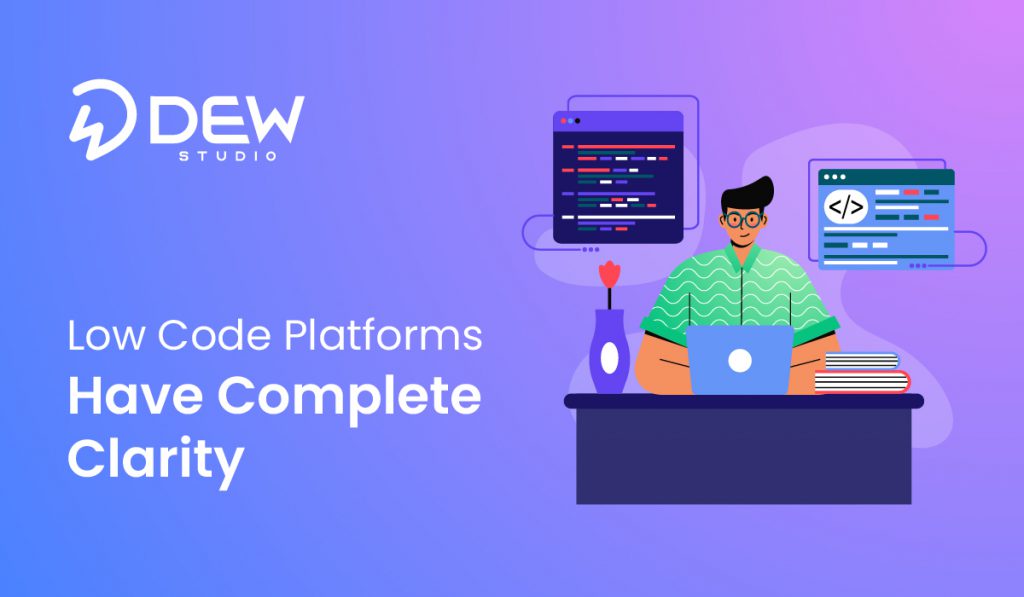
Low-Code platforms have already started redefining the world of software development- for good reasons. When it comes to developing mobile or web apps, low code solutions have made things easier for developers with limited experience.
As the experts in this field and the creators of DEW Studio-the best low-code platform, we have seen the evolution and advantages of using low-code solutions first hand. Now, this article tells you about the key benefits of using low code platforms for your development projects
Reduced development time and cost:
Low code platforms will reduce the obstacles to entry, development time and cost. You don’t need to have a developer with extensive experience and knowledge, rather you will be able to use developers with basic knowledge of code functionalities. For example, a business user with basic programming knowledge will be able to create the workflows. Our low -code platform DEW Studio enables businesses to save 50% on development time and cost.
Easy integration:
Popular low code platforms can substantially boost the agility in your application development process, as organizations can easily integrate them in their legacy mainframe systems. The easy integration ensures faster development, more resilient solutions and quick adaptability.
Rapid solutions developed by business users:
In this super-personalized market, creating a solution that runs uniformly across an omnichannel eco-system is the key to success. Low code platforms enable business users with limited technical knowledge to assemble their solutions. One of the vital reasons why low code platforms are growing in popularity is due to them breaking the traditional organizational development status quo.
Improved SDLC with Low-Code:
Low code platforms have made it easy for businesses to innovate new solutions by eliminating the complex technology bottleneck at the entry point. With a low code platform, a developer with basic knowledge can create an excellent digital experience. Furthermore, they also substantially shorten the development lifecycle.
Rapid business automation:
Popular low code platforms like DEW envision a world where any business process can be automated in minutes. This is one of the best opportunities that low code platforms present for organizations. Using a low-code platform, an organization can easily automate many of its workflows. Thanks to the technology, five years down the line just about anyone can be a developer.
Lower maintenance responsibilities:
Popular low code platforms come with pre-tested, standardized and ready-made components, so developers spend much less time fixing bugs and integration than the legacy development approach. By investing less time on maintenance, developers can invest their time on other crucial functions.
Rise of citizen developers:
With continuous unique demand for applications, developers often find it difficult to keep up. This is where citizen developers can play a major role by developing unique business solutions and simplifying automation processes. With minimal code and simple logic, citizen developers can build the required applications. This building-block approach significantly reduces the development time, thus, promoting a faster time-to-market approach.
Increased team productivity:
When it comes to handling a critical and real-time issue, a low code development tool enables developers and business professionals to work hand in hand to solve the problem. Business users can create their workflows without depending on their IT team.
Fast prototyping:
Advanced low code solutions allow non-technical professionals to prototype solutions quickly. These solutions can be tested, refined and prototyped without having to involve a skilled development team.
Low Code-Better focus on business development
Popular low code platforms allow developers to create more complex applications with less code than the regular development process. This way organizations will be able to focus more on their business development activities. Developers can make the Minimum Viable Product (MVP) very quickly and get feedback.
Now you might have realized the potential of a low code platform, but before using any of these tools you should know some important facts about low code platforms-
It’s not a no-code development approach:
The platforms have a drag and drop feature that allows you to rely on a visual interface instead of writing lines of code.
In a no-code environment, anyone with zero programming language skills can use the drag and drop feature to develop an application.
Everything in a no-code environment comes with a visual interface so that anyone can create the required application without any hassle.
When it comes to developing an enterprise-level or complex application, you cannot fully rely on a no-code development approach as there are some parts that you cannot develop without writing code.
Crucial features of low code platforms:
Visual modeling: almost 80% of the development stages are presented visually. The graphics-heavy interfaces make things easier for developers to understand and execute than writing lines of code and syntax.
Drag-and-drop interface: this feature enables the developer to drag and drop components instead of writing code, thus saving a considerable amount of time.
Code-generator: a low code platform like DEW automatically generates the code for you.
Declarative: using different business rules and functional models, low code platforms implement declarative tools. This means you won’t have to use any custom code. You can change or add any code in the future.
Are you looking forward to using the best low code platform that enables you to save more than 50% on development time and costs?
You have just landed on the right page, as DEW is the most comprehensive and user-friendly low code platform that enables you to automate any business process.

